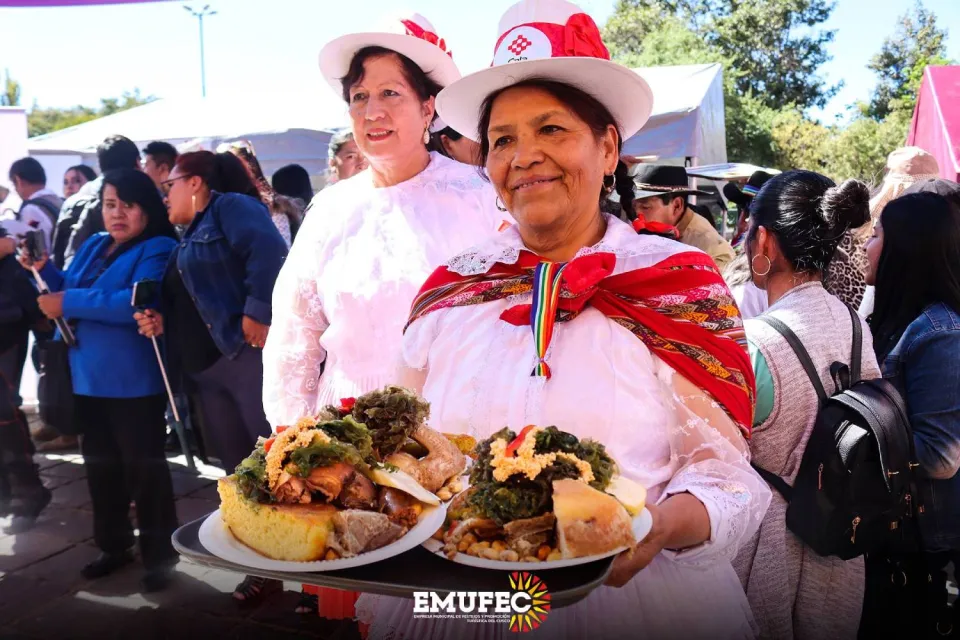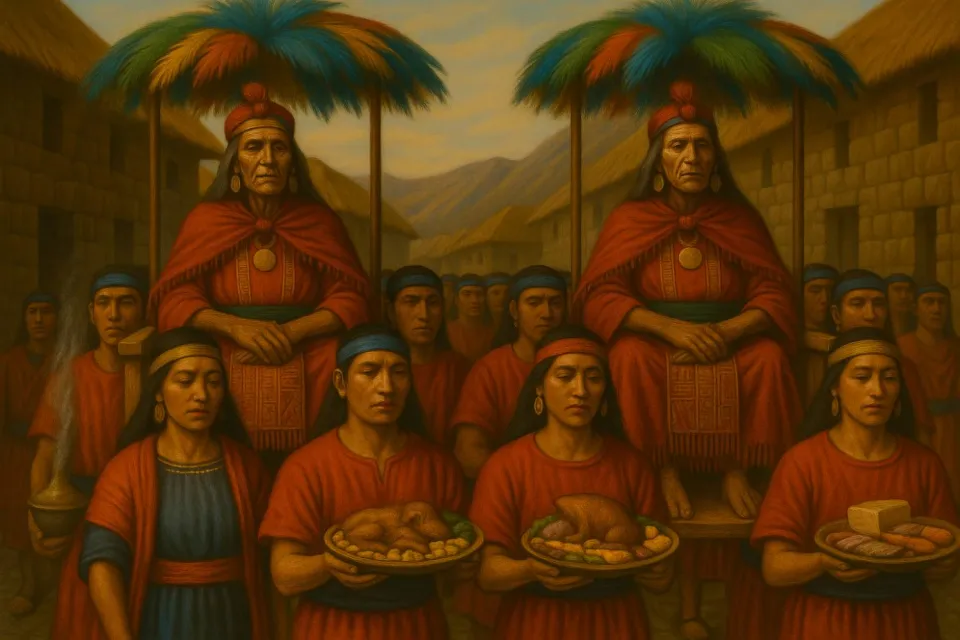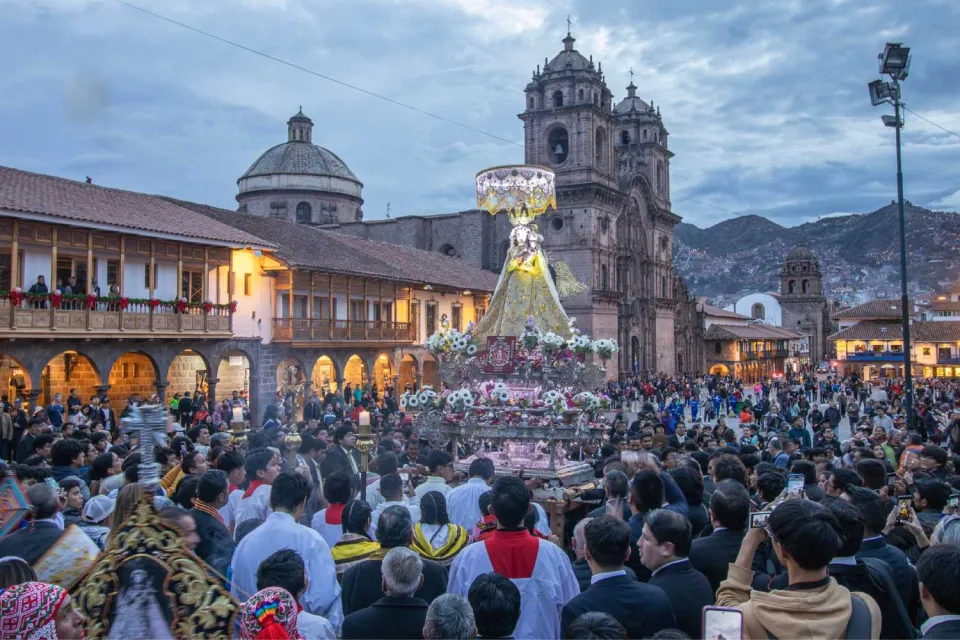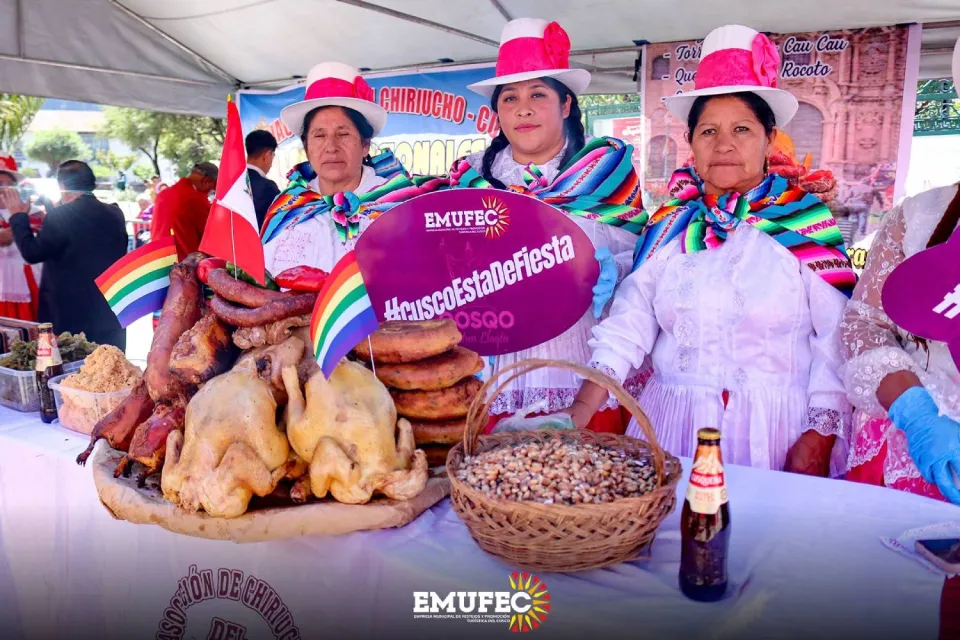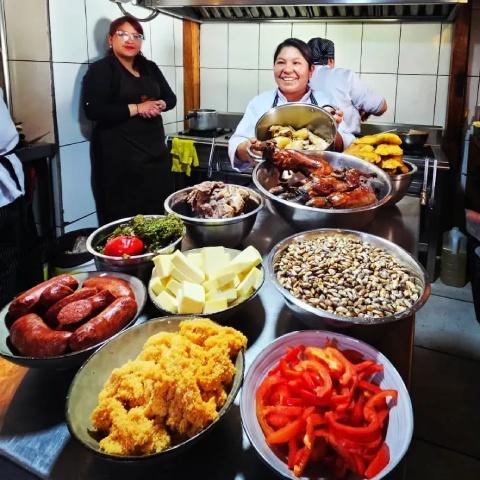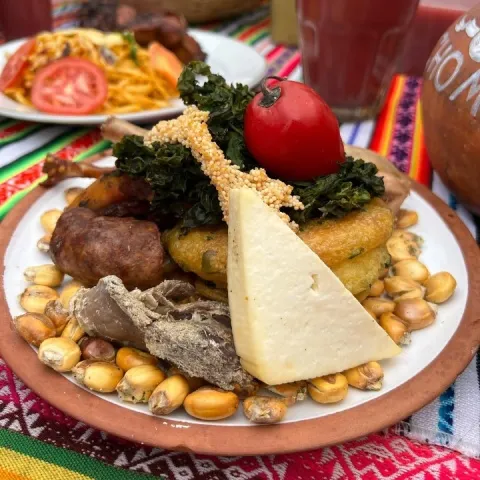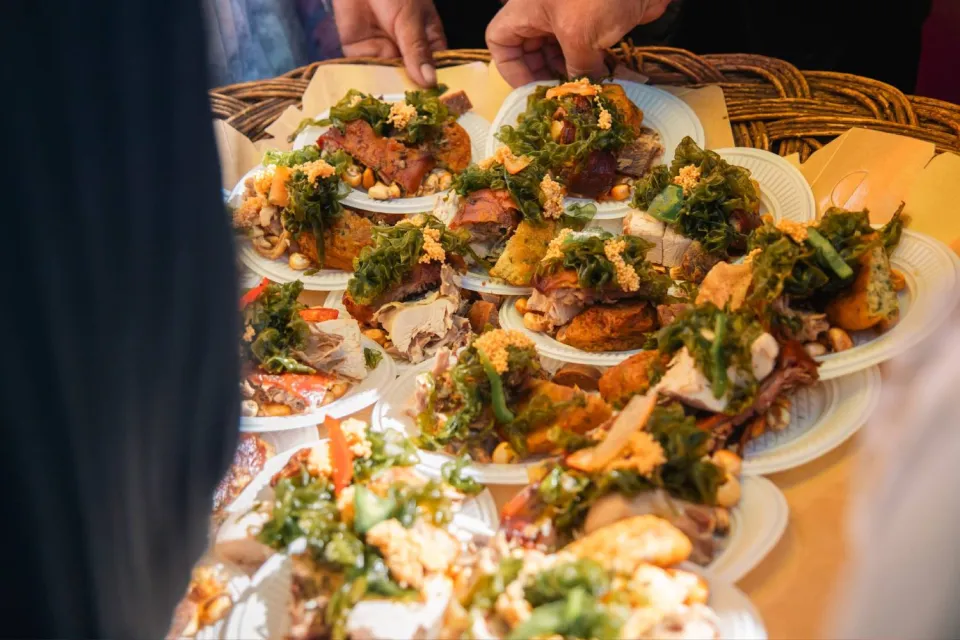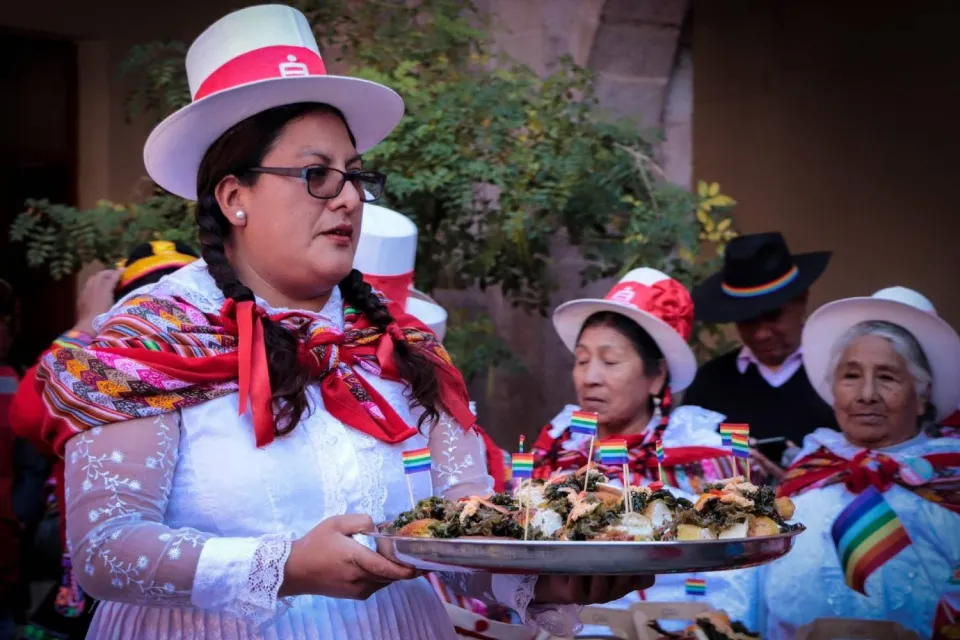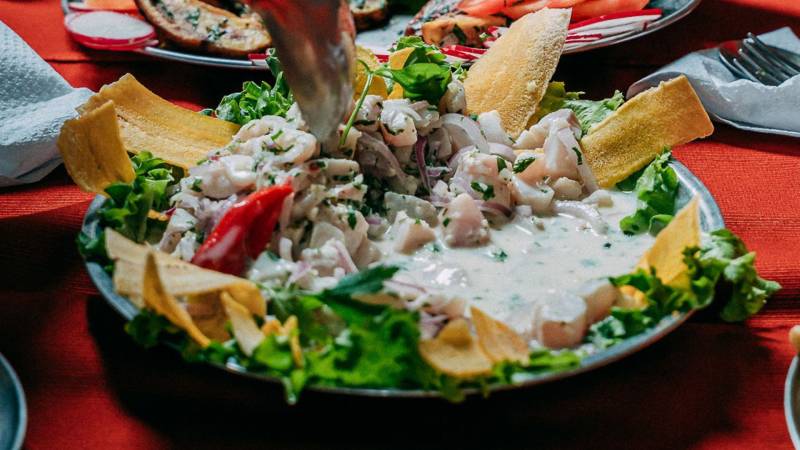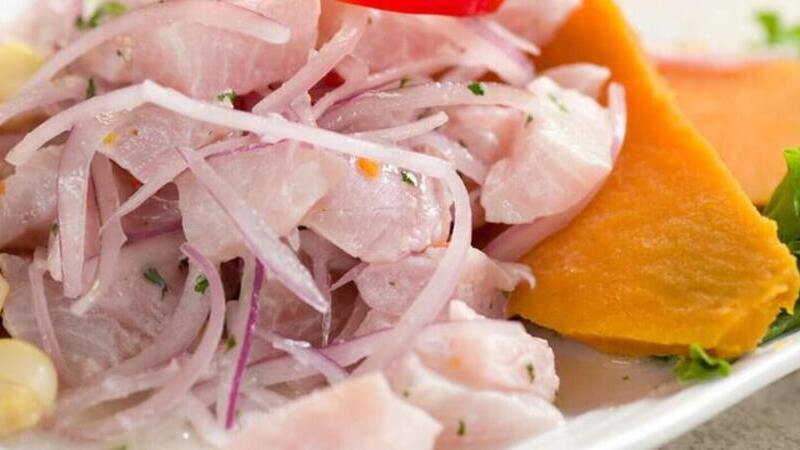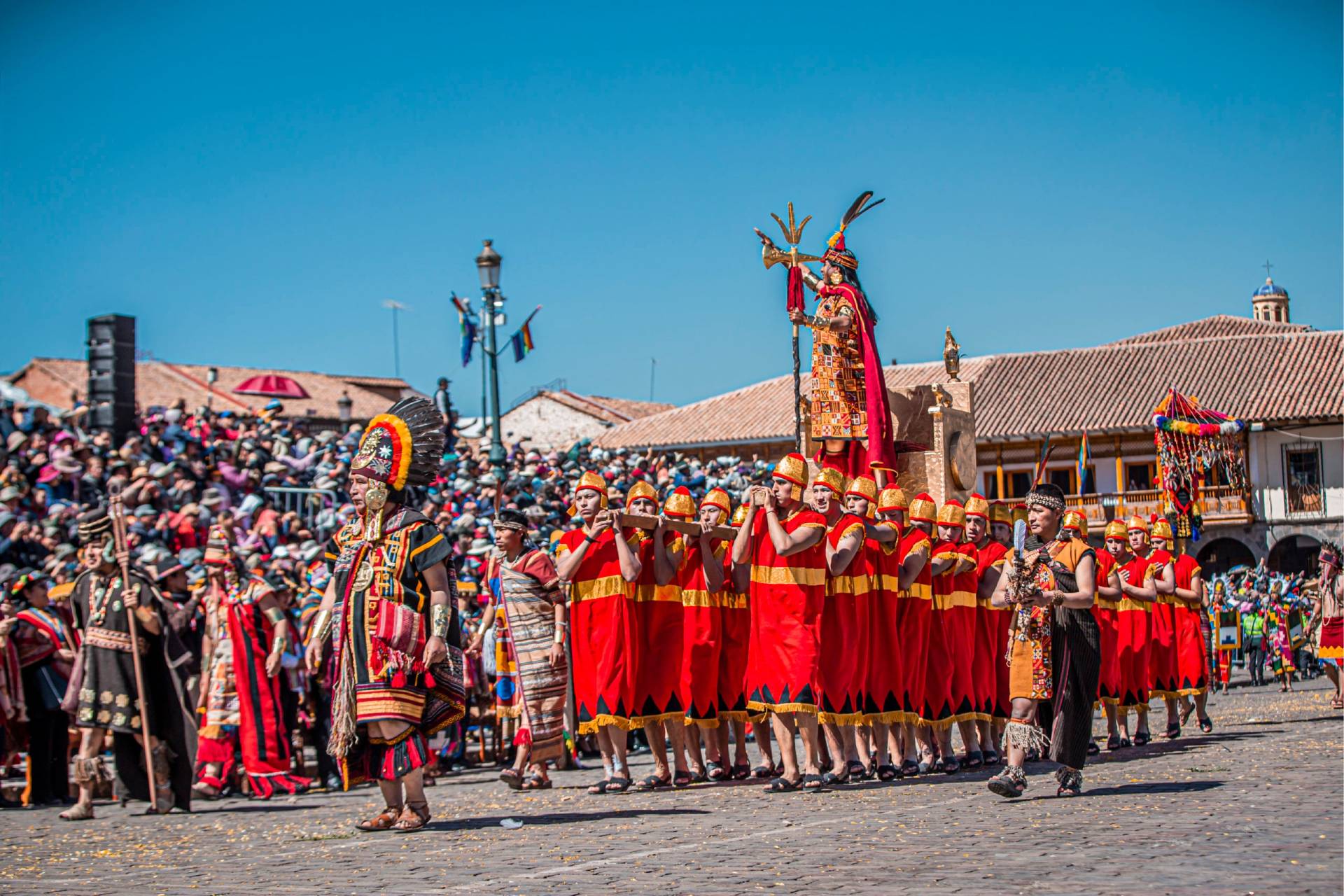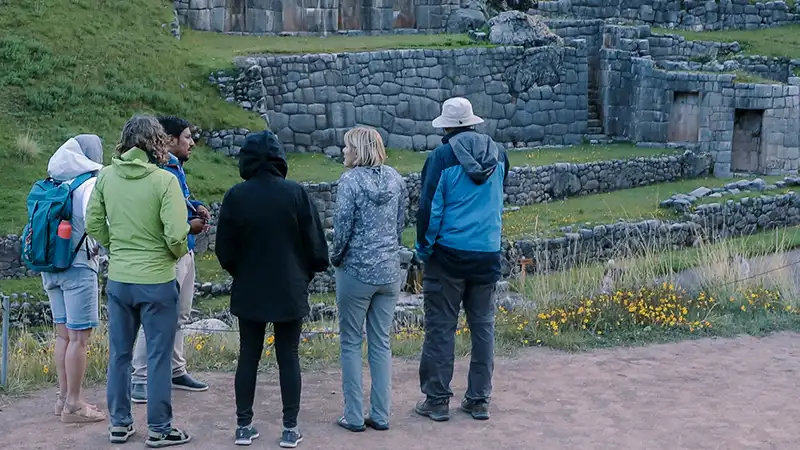When it comes to Cusco cuisine, few dishes have the capacity to tell stories like chiriuchu.
This feast of ingredients from the coast, highlands and jungle is not only delicious: it is the summary of centuries of cultural encounters, conquests and celebrations that marked the destiny of Cusco. And yes, its cold taste hides an ancestral secret that will surprise you.
What is Chiriuchu?
Chiriuchu is the flagship dish of Cusco's festivities, especially Corpus Christi. It is served cold and combines ingredients from the coast, highlands and jungle of Peru, resulting in a delicious and unique flavor.
Its history mixes Inca origins with colonial influences, so it is much more than a dish: it is a living sample of the union of cultures and regions.
In addition, it is the only Cusquenian dish that has gastronomic festivals dedicated exclusively to it, celebrated on three key dates: the entrance, the central day and the octave of Corpus Christi.
What does Chiri uchu mean?
Its name comes from two Quechua words:
- Chiri = cold
- Uchu = chili
Therefore, its literal translation is "cold chili", "cold spicy" or "cold food with a spicy touch".
Why is it considered a symbol of Cusco identity?
Chiriuchu is much more than a traditional dish; it is a cultural emblem that reflects the history of encounters, exchanges and the adaptation of customs in the diversity of Cusco.
It brings together typical ingredients of Cusco's gastronomy, from native meats such as guinea pig to Cusco's agricultural products, evidencing the deep connection between the people and their territory.
Being prepared only on important dates, it symbolizes the identity, celebration and pride of being part of the Cusco culture.
For all these reasons, chiriuchu is not only a delicacy, but also a living symbol that unites generations and expresses the essence of Cusco
The history behind the Chiriuchu
Origin of the Chiriuchu
There is no single version of the origin of the chiriuchu. There are several theories, all of them going back to the Inca empire.
Inca ceremonial dish
During the month of celebration of the Wawa Inti Raymi, the people of the Tahuantinsuyo used to arrive bringing the mummies of ancient Inca rulers from their respective temples.
This happened because, in the current Plaza de Armas of Cusco, there was a procession in which the people carried the mummies on their shoulders to the Qoricancha. This practice also gave rise to Corpus Christi.
At the end of the ceremonies, the villagers attended banquets in the Qoricancha to share with the royalty. This was a direct invitation from the Sapa Inca.
To correspond to this special request, the villagers brought the best and most representative products of their regions. Upon arrival, they delivered these ingredients for the banquets. At these banquets, dishes were offered to the Sun God as a token of gratitude for giving his warmth to the earth, and offerings were also made to the Inca mummies and the Sun God.
One of these offerings was the Chiriuchu. It was prepared with the ingredients brought by the people and, being an offering, it had to return with the mummies to their temples. For this reason, it was served cold so that it would be better preserved.
The people also consumed this dish at the banquet, and discovered that eating it cold brought out its natural flavor. This way of eating it gave it a special meaning, as it represented duality: the sun symbolizes heat, while the dish is served cold.
The main ingredients of this dish were corn, tubers, guinea pig and charqui (dried meat).
Ayni sharing dish
In Inca times, there were three work systems, one of them was the Ayni, which consisted of reciprocity among members. When a villager needed help to build or sow, the others came voluntarily.
After the workday, the families that helped would bring food to share. Whoever received the help would take the best of his or her pantry to treat the others. With all these ingredients, community dishes were prepared.
As the ayllus could include families from the coast, the jungle and the highlands, a varied dish was obtained. When served cold after work in the fields, its Andean duality was reinforced.
The chronicler Sarmiento de Gamboa, in 1572, explained that the Incas divided their food into two categories: those coming from the land, such as cereals, were considered "males" (orqo) and the rest, "females" (china).
The chiriuchu, by bringing together "male" and "female" ingredients, represented this duality. Other historians point out that the dish also symbolizes the duality of the Hanan and the Hurin, principles that helped maintain order in Andean society.
Connection with Corpus Christi
The arrival of the Spaniards brought great changes to the Inca empire and to the city of Cusco. They sought to impose the Catholic religion and eradicate Inca religion. To achieve this, they tore down Inca temples and built churches for virgins and saints in their place.
They prohibited ceremonies such as the Inti Raymi, but as the people continued to practice them, they decided to replace some customs. For example, instead of processions with Inca mummies, they held processions with saints and virgins, and thus Corpus Christi was born.
What happened to the Chiriuchu? The Spaniards accepted its popularity and knew that prohibiting it could generate conflicts. Therefore, they adapted it to their customs, incorporating ingredients such as chorizo and cheese.
Actuality
The chiriuchu became a living reminder of Cusco's history. Today, it accompanies the Corpus Christi festivity, since both come from the Inti Raymi celebrations.
It is massively consumed on these special dates, as an expression of Cusco's identity and the continuity of ancestral practices that are deeply rooted in the region.
Ingredients of Chiriuchu
Chiriuchu is a unique dish that fuses ingredients from different regions of Peru, becoming a delicious expression of the country's diversity.
- Hen (1 ½ kg) or boiled chicken - Represents the highlands.
- Cuy chactado (baked guinea pig) - Also from the highlands, it is an ancestral tradition.
- Charqui or chalona (dried alpaca or beef) - It is dehydrated with salt and sun.
- Huevera de pescado or cau cau - Ingredients brought from the Peruvian coast.
- Fresh cheese (100 grams)
- Corn tortilla or maí flour
- Seaweed (50 grams, yuyo or cochayuyo) - Represents the coast.
- Rocoto or hot bell pepper
- Toasted corn (cancha serrana)
- 2 chorizos or blood sausage.
- 1 carrot
- 2 stalks of poro
- Whole pepper and salt to taste
- Huacatay
The chiriuchu sausages are special, prepared exclusively for this festivity. They are elaborated with previously washed mutton tripe and stuffed with pork, huacatay and toothpick.
Corn tortilla
- 3 beaten eggs
- 50 grams of corn flour
- 130 grams of pumpkin puree
- Baking powder
- Chopped Chinese onion
- Salt, pepper and chopped onion to taste
How to prepare chiriuchu?
Although each family gives it its own special touch, here is a simple guide for you to learn how to prepare this feast. Keep in mind that the preparation should preferably begin the day before, in the afternoon or evening.
1. Prepare the meats
Start with the guinea pig. Clean it well and season it inside and out with salt, cumin, garlic and huacatay. Place huacatay branches inside to absorb the flavor. Let it rest for a few minutes and then bake it for about 45 minutes, until it is golden brown and evenly cooked.
Meanwhile, boil the free-range chicken in a small amount of water with carrots, leeks, celery, oregano, black pepper and a touch of salt to enhance its flavor. Once cooked, remove it from the broth and cut it into portions. Do not discard the broth, as you will use it later.
In another pot, cook the shallots until soft. Let it cool, cut it into strips or small pieces and set aside. Then, fry the chorizos until they are well cooked inside.
2. Prepare the accompaniments
Toast the cancha serrana in a preheated frying pan to achieve an even, crispy toast.
Cut the queso fresco into slices or cubes, as you prefer. Separately, wash the seaweed and boil it and the fish roe until soft.
Clean the rocoto and cut it into thin strips. If you can, buy colored rocoto, as it serves as a garnish and adds the characteristic spicy touch.
Remember to soak the egg cup a few hours before and then boil it in water so that it is just right.
3. Prepare the tortillas
These are usually prepared the same day the chiriuchu is served. Remember: without a good tortilla, there is no good chiriuchu!
In a bowl, mix the cold chicken broth with the beaten eggs, corn flour, baking powder and a pinch of salt, pepper and cumin until a homogeneous dough is formed.
Add pumpkin puree to give it a smooth texture and add chopped Chinese onion.
Heat a frying pan with oil and, when it is very hot, pour the mixture forming small and medium round shapes. Fry until golden brown.
4. Assemble the dish
Cut the guinea pig into pieces and remove the huacatay from inside. On a large plate, arrange a base with small portions of each ingredient.
Place the meats first: chicken, guinea pig and charqui. Arrange the cancha serrana (roasted corn) and the queso fresco in one corner.
On top, add a couple of tortillas, the chorizo, the cochayuyo, the huevera and, at the top, decorate with colored rocoto strips to crown this feast. And that's it! You will have a delicious chiriuchu ready to enjoy.
When is chiriuchu eaten?
Cusqueños celebrate Corpus Christi in May or June with chiriuchu as the typical dish. Vendors fill the streets with processions, masses, and tables full of offerings of this dish to both tourists and locals during those days.
It is very traditional to eat it on that feast day, although nowadays some restaurants also serve it on other dates so that visitors can enjoy the experience at any time.
Where to eat chiriuchu in Cusco?
If you visit Cusco and want to try a good chiriuchu, here are some recommended options:
The chiriuchu festival
People celebrate this festival three times a year, and it stands out because during those days vendors sell only this traditional dish.
Organizers hold this festival during the three days of Corpus Christi. You will find numerous stalls where you can enjoy chiriuchu and even order it to take away.
The municipality and EMUFEC regulate these fairs, ensuring that they have all the security measures, order, and cleanliness necessary to receive visitors from all over the world.
Traditional restaurants
These are restaurants specialized in typical Cusco dishes. They receive national, foreign and local tourists, and usually offer music shows and traditional dances while you taste the chiriuchu.
A good example is La Cusqueñita, which has several locations in Cusco (although they are not so close to the historic center).
Restaurants in the historic center
These restaurants are more touristy and offer a variety of dishes for foreign visitors to sample the local cuisine. Like the traditional restaurants, some include shows to liven up the experience.
Some recommended examples are:
- Pachapapa
- Chicha by Gaston Acurio
- Cicciolina
Hotel restaurants
The most luxurious hotels in Cusco usually have restaurants that offer typical dishes of the region, and here you can also find this delicacy.
Local markets
During the Corpus Christi festivities, street vendors fill local markets such as San Pedro with stalls where you can also try Chiriuchu
How do you eat Chiriuchu?
We know you want to enjoy this stew like a true local, so here are some tips:
- This dish is eaten with your hands, so it's ideal to keep them clean.
- Start by tasting a piece of seaweed and bring it to your mouth.
- Then follow with the egg cup, a piece of tortilla, the cheese and the charqui.
- Then, savor the meats: some guinea pig, chicken, chorizo and cancha serrana. If you like it spicy, add some rocoto.
- Chew it all together in one bite so you can enjoy the explosion of flavors and the mix of cultures that this dish represents.
Benefits of chiriuchu
Although people consume chiriuchu mainly during festivities and not every day, they find that it has very interesting benefits:
- Cultural contribution: By eating it, you connect with a living tradition of Cusco and with the history of the city.
- Varied nutritional value: The guinea pig, charqui and chorizo provide essential proteins and iron for the body; the cheese is rich in calcium, and the other ingredients offer beneficial minerals and vitamins.
- Diversity of flavors: Cooks prepare each ingredient differently, so each bite offers a unique and different flavor.
- Rich in fiber: Ingredients such as cancha serrana and seaweed are excellent sources of fiber, which aid digestion.
- Low in carbohydrates: Unlike other typical dishes, chiriuchu has a low carbohydrate content, so it can be included in low-carbohydrate diets.
- High satiety power: Being a generous dish full of variety, it leaves you satisfied. It is ideal for sharing with family or friends.
- Symbolic and spiritual value: Many people consider chiriuchu an offering that unites the Andean and the mestizo. Eating it is to participate in a tradition that celebrates fertility, abundance and the union of cultures.
- Supporting the local economy: In addition to enjoying a delicious and nutritious dish, by eating it you help small local producers and traders.
Curiosities about the Chiriuchu
- Many consider it the gastronomic union of the four suyos of the Tahuantinsuyo.
- People usually consume it in May and June, since Corpus Christi can fall in either of those months.
- The dish represents the duality of the Inca world, because the people offered it to the Sun (heat) but consumed it cold.
- Cooks place each ingredient in a precise order, symbolizing the abundance and order of the universe.
- For many tourists, the torrejas and the chorizo are the best part of the dish. Its preparation begins a day before, because it is a very elaborate dish.
- Each ingredient has a symbolism: the guinea pig represents fertility and abundance; the torreja symbolizes bread and family unity.
- The vendors are usually very friendly, so don't hesitate to photograph them! The dish is usually a bit greasy and salty, so don't be surprised.
- The taste may vary slightly, as each Cusco family has its own style of preparing chiriuchu.
- At festivals, more than 300 cooks gather to sell this traditional stew.
Practical tips for tasting a good chiriuchu
- Choose the best torrejas: At the festival you will find many stalls offering this dish, but the ones that include colorful and fluffy torrejas usually prepare delicious and quality chiriuchu.
- Observe the cleanliness of the place: Although the stalls go through several security checks, the movement of the day can cause them to neglect cleanliness. Check that the place is clean to avoid stomach discomfort.
- Check the condition of the ingredients: Before consuming, make sure the food looks fresh, with no unpleasant odors or color changes. Avoid exposing your dish to the sun for too long: Prolonged exposure can cause food to spoil, which could upset your stomach.
- Enjoy it slowly: This dish has many ingredients. To savor it best, try a small portion of each one separately and then combine the flavors a little at a time to appreciate the full variety.
- Bring cash: Most stalls only accept cash payments, so it is best to bring money in small denominations to make shopping easier
Frequently asked questions
- Why is it eaten cold?
It is a tradition that mixes customs and flavors. Ancient Andean rituals for the Inca deities gave rise to this dish; people would leave it as an offering on altars and let it cool in the open air. Over time, this became part of the identity of the festivity.
In addition, people prepare many of the ingredients and then keep them at room temperature until they finish the whole preparation, which helps maintain its characteristic flavor.
- Is its flavor spicy or mild?
Its flavor is special, but mild. It is not spicy and has a salty touch. When you taste it, you will notice a mixture of flavors and textures thanks to the variety of meats it contains.
If you like it spicy, you can ask for rocoto, which will give it that fiery touch that many enjoy.
- How long does the preparation take?
This dish requires between 5 and 8 hours of preparation, since each ingredient has its own process:
- Sancochada chicken: 2 hours (includes cleaning, boiling and shredding).
- Baked guinea pig: 1 hour and 15 minutes (cleaning, marinating and frying).
- Huevera and other ingredients: 30 minutes (boil and fry egg cup, cook corn, prepare cheese and hard-boiled egg).
- Corn roasting and decoration: 40 minutes (mix, fry and drain).
- Final assembly: 20-30 minutes (arrange all the ingredients on the plate).
- Is it safe to eat at festivals?
Yes. The Regional Government of Cusco supervises these festivals and ensures that all stalls comply with hygiene and safety standards in the preparation of food.
- When is the chiriuchu festival in 2025?
Organizers will hold the gastronomic festival of this emblematic dish on Wednesday, June 18 and 19 from 9:00 a.m. in the Plaza San Francisco, just a few meters from the Plaza de Armas.
Another key date is Thursday, June 26, corresponding to the octave of Corpus Christi in Cusco.
These dates vary each year, since they depend on the lunar calendar and religious festivities.
- Do people only prepare it during Corpus Christi?
Mainly, yes, its massive consumption occurs during the Corpus Christi festivity. However, people also prepare it in other religious celebrations such as the Cruz Velacuy.
- Can I find it in restaurants in any month of the year?
Yes, some tourist restaurants in Cusco such as the Cusqueñita offer it at any time of the year. However, I recommend you check first with the restaurant to confirm availability.
- How many plates of chiriuchu do vendors sell during Corpus Christi?
Experts estimate that vendors sell between 28,000 and 70,000 dishes during the celebrations.
For example, in 2018, vendors served about 28,000 dishes, while in 2023, more than 230 vendors offered about 70,000 dishes between May 29-30 and June 6.
- Can I order it without cuy?
Of course you can! When ordering, tell the vendor that you prefer it without guinea pig, and she will prepare your dish to your liking.
- What is the drink that traditionally accompanies Chiriuchu?
Although there is no official drink, chicha de jora is the favorite of Cusqueños to accompany this dish. You can also enjoy it with a Cusquenian beer or any non-alcoholic beverage.
- How much do people usually pay on average for this dish?
During festivals, the average price is usually 35 soles (about 10 dollars).
- Can I try it while I am acclimatizing?
We do not recommend trying it on the first day of acclimatization because we suggest eating light and easy-to-digest meals, such as homemade chicken soups.
When you acclimatize better, don’t hesitate to try it—you will love it!
- Where can I find chiriuchu in Lima?
Cusquenian restaurants such as Sabor Cusqueño serve it, and chefs prepare it at gastronomic fairs and regional festivals featuring dishes from all regions of Peru.
Chiriuchu is not just a dish, it is a culinary and cultural experience that connects directly with the living history of Cusco.
You already know what it is, where it comes from, how it is prepared, what ingredients it contains and where to try it. So, if you visit Cusco in June, don't miss the opportunity to taste this delicious delicacy!
Do you dare to try it?

